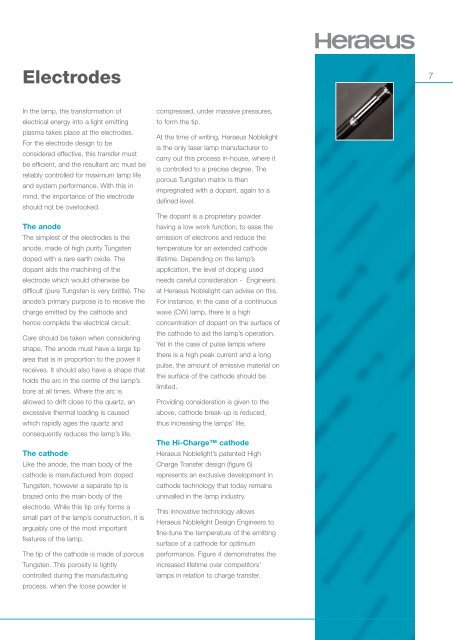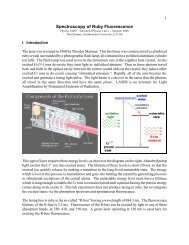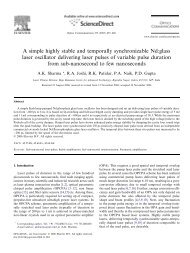Heraeus Noblelight Flashlamp..
Heraeus Noblelight Flashlamp..
Heraeus Noblelight Flashlamp..
Create successful ePaper yourself
Turn your PDF publications into a flip-book with our unique Google optimized e-Paper software.
Electrodes<br />
7<br />
In the lamp, the transformation of<br />
electrical energy into a light emitting<br />
plasma takes place at the electrodes.<br />
For the electrode design to be<br />
considered effective, this transfer must<br />
be efficient, and the resultant arc must be<br />
reliably controlled for maximum lamp life<br />
and system performance. With this in<br />
mind, the importance of the electrode<br />
should not be overlooked.<br />
The anode<br />
The simplest of the electrodes is the<br />
anode, made of high purity Tungsten<br />
doped with a rare earth oxide. The<br />
dopant aids the machining of the<br />
electrode which would otherwise be<br />
difficult (pure Tungsten is very brittle). The<br />
anode’s primary purpose is to receive the<br />
charge emitted by the cathode and<br />
hence complete the electrical circuit.<br />
Care should be taken when considering<br />
shape. The anode must have a large tip<br />
area that is in proportion to the power it<br />
receives. It should also have a shape that<br />
holds the arc in the centre of the lamp’s<br />
bore at all times. Where the arc is<br />
allowed to drift close to the quartz, an<br />
excessive thermal loading is caused<br />
which rapidly ages the quartz and<br />
consequently reduces the lamp’s life.<br />
The cathode<br />
Like the anode, the main body of the<br />
cathode is manufactured from doped<br />
Tungsten, however a separate tip is<br />
brazed onto the main body of the<br />
electrode. While this tip only forms a<br />
small part of the lamp’s construction, it is<br />
arguably one of the most important<br />
features of the lamp.<br />
The tip of the cathode is made of porous<br />
Tungsten. This porosity is tightly<br />
controlled during the manufacturing<br />
process, when the loose powder is<br />
compressed, under massive pressures,<br />
to form the tip.<br />
At the time of writing, <strong>Heraeus</strong> <strong>Noblelight</strong><br />
is the only laser lamp manufacturer to<br />
carry out this process in-house, where it<br />
is controlled to a precise degree. The<br />
porous Tungsten matrix is then<br />
impregnated with a dopant, again to a<br />
defined level.<br />
The dopant is a proprietary powder<br />
having a low work function, to ease the<br />
emission of electrons and reduce the<br />
temperature for an extended cathode<br />
lifetime. Depending on the lamp’s<br />
application, the level of doping used<br />
needs careful consideration - Engineers<br />
at <strong>Heraeus</strong> <strong>Noblelight</strong> can advise on this.<br />
For instance, in the case of a continuous<br />
wave (CW) lamp, there is a high<br />
concentration of dopant on the surface of<br />
the cathode to aid the lamp’s operation.<br />
Yet in the case of pulse lamps where<br />
there is a high peak current and a long<br />
pulse, the amount of emissive material on<br />
the surface of the cathode should be<br />
limited.<br />
Providing consideration is given to the<br />
above, cathode break-up is reduced,<br />
thus increasing the lamps’ life.<br />
The Hi-Charge cathode<br />
<strong>Heraeus</strong> <strong>Noblelight</strong>’s patented High<br />
Charge Transfer design (figure 6)<br />
represents an exclusive development in<br />
cathode technology that today remains<br />
unrivalled in the lamp industry.<br />
This innovative technology allows<br />
<strong>Heraeus</strong> <strong>Noblelight</strong> Design Engineers to<br />
fine-tune the temperature of the emitting<br />
surface of a cathode for optimum<br />
performance. Figure 4 demonstrates the<br />
increased lifetime over competitors’<br />
lamps in relation to charge transfer.





